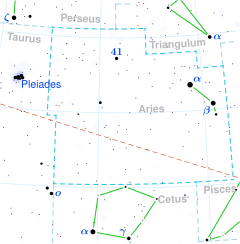| Observation data Epoch J2000 Equinox J2000 | |
|---|---|
| Constellation | Aries |
| Right ascension | 02h 49m 59.03324s[1] |
| Declination | +27° 15′ 37.8260″[1] |
| Apparent magnitude (V) | 3.63[2] |
| Characteristics | |
| Spectral type | B8 Vn[3] |
| U−B color index | –0.38[2] |
| B−V color index | –0.10[2] |
| Astrometry | |
| Radial velocity (Rv) | +4[4] km/s |
| Proper motion (μ) | RA: +66.81[1] mas/yr Dec.: –116.52[1] mas/yr |
| Parallax (π) | 19.69 ± 0.19 mas[1] |
| Distance | 166 ± 2 ly (50.8 ± 0.5 pc) |
| Details | |
| Mass | 3.1±0.1[5] M☉ |
| Luminosity | 160[6] L☉ |
| Temperature | 11900[6] K |
| Rotational velocity (v sin i) | 175[7] km/s |
| Age | 130+10 −30[5] Myr |
| Other designations | |
| Database references | |
| SIMBAD | data |
41 Arietis (abbreviated 41 Ari) is a triple star system in the northern constellation of Aries. With an apparent visual magnitude of 3.63,[2] this system is readily visible to the naked eye. It has an annual parallax shift of 19.69 mas,[1] which indicates it is at a distance of 166 light-years (51 parsecs) from the Sun.
The system consists of a binary pair,[9] designated 41 Arietis A, together with a third companion star, 41 Arietis D. (41 Arietis B and C form optical pairs with A, but are not physically related.[10]) The components of A are themselves designated 41 Arietis Aa (formally named Bharani /ˈbærəni/)[11] and Ab.
- ^ a b c d e f Cite error: The named reference
aaa474_2_653was invoked but never defined (see the help page). - ^ a b c d Cite error: The named reference
clpl4_99was invoked but never defined (see the help page). - ^ Cite error: The named reference
aj77_750was invoked but never defined (see the help page). - ^ Cite error: The named reference
gcsrvwas invoked but never defined (see the help page). - ^ a b Cite error: The named reference
apj736_2_89was invoked but never defined (see the help page). - ^ a b Cite error: The named reference
aj143_6_134was invoked but never defined (see the help page). - ^ Cite error: The named reference
apj573_1_359was invoked but never defined (see the help page). - ^ Cite error: The named reference
SIMBADwas invoked but never defined (see the help page). - ^ Cite error: The named reference
mnras389_2_869was invoked but never defined (see the help page). - ^ "Washington Double Star Catalog". United States Naval Observatory. Archived from the original on 2011-02-14. Retrieved 2 January 2018.
- ^ "Naming Stars". IAU.org. Retrieved 16 December 2017.
